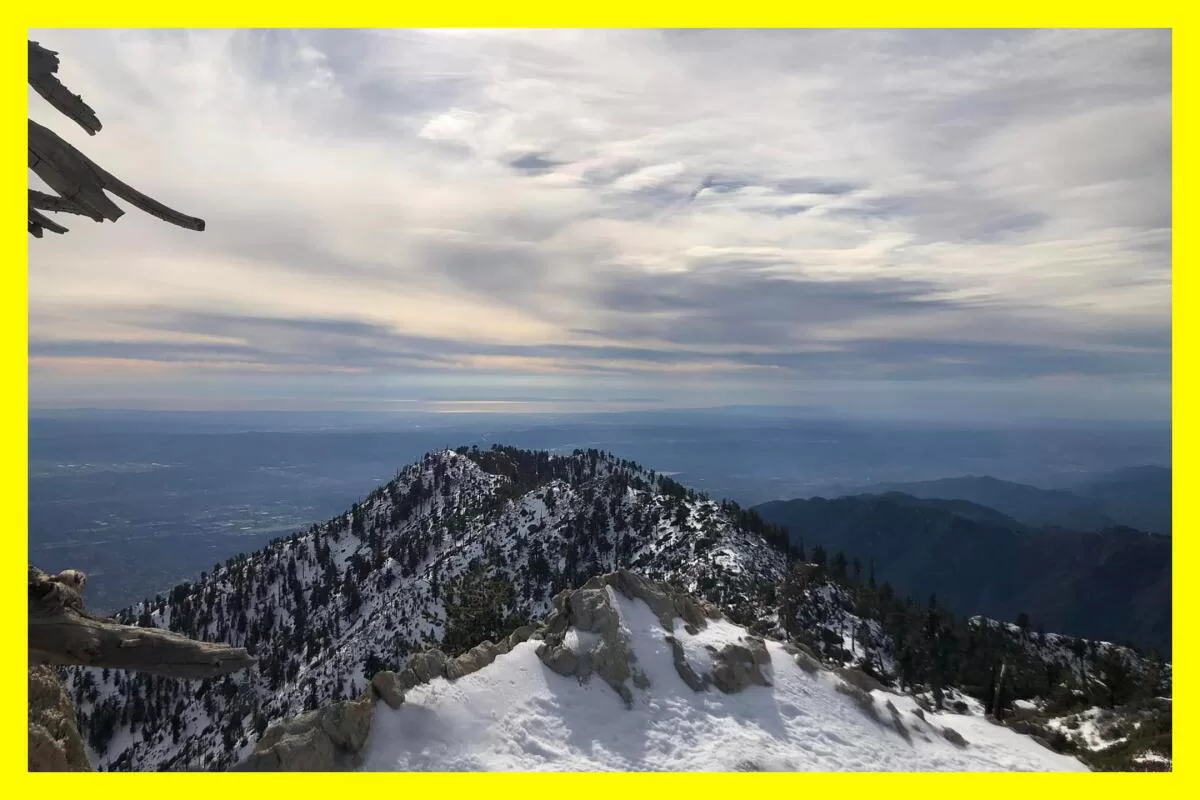I remember feeling kind of like a celebrity in that Chipotle in Upland.
It was a Thursday in 2021, and my dog and I had just hiked Cucamonga Peak, an 11.1-mile trek where you gain almost 4,200 feet in elevation. I was exhausted, and about to devour a massive burrito bowl. But the moment I told the guests in line what I’d just done, half the restaurant wanted to see pictures and hear about my experience. I was excited to share, if a little hungry.
Newsletter
You are reading The Wild newsletter
Sign up to get expert tips on the best of Southern California’s beaches, trails, parks, deserts, forests and mountains in your inbox every Thursday
You may occasionally receive promotional content from the Los Angeles Times.
That was the first year I completed the SoCal Six Pack of Peaks challenge. The annual self-guided program, which launched in 2015, has helped me bag some of the highest peaks in Southern California. Today, the challenge includes 12 peaks to choose from. It costs $50 to register, and participants who complete six peaks in the challenge are awarded with swag, a paper certificate and bragging rights.
I participated in both 2021 and 2022, and hiked eight peaks I’d never visited — including Ontario Peak when it was covered in snow. (Shout out to Geoff, my wilderness-savvy friend, who coached me through the perils of winter hiking.)
I signed up for the SoCal Six Pack of Peaks for two main reasons: accountability and trail logs. I hiked more in the two years I participated in the challenge than at any other time in my life. In part because I kept in mind that I had paid my money to participate, and I didn’t want it to go to waste — or to let myself down. Thanks to that contract with myself, I got to see beautiful places and make great memories.
Once I registered, I also gained access to the trail logs of past participants. This was crucial information, especially when I hiked Ontario Peak in the winter with my friend. We got up-to-date information about trail conditions that allowed us to plan for the worst and see the highlights, including where to watch for a frozen waterfall.
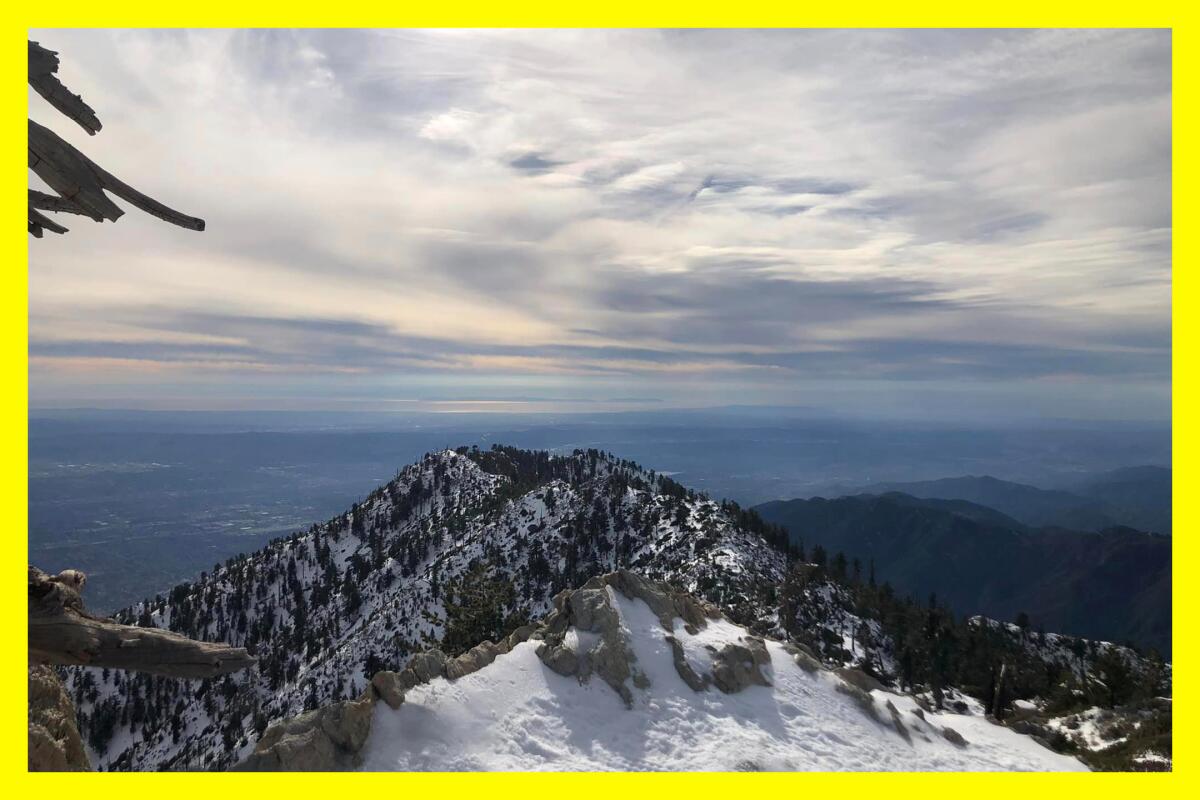
The snow-covered trail to Ontario Peak in December 2022.
(Jaclyn Cosgrove / Los Angeles Times)
Jeff Hester, the chief adventure officer at Social Adventures, wasn’t planning to launch a business when he started the SoCal Six Pack challenge. The endeavor began in 2010, when he broke his wrist while mountain biking, and needed something to do outside.
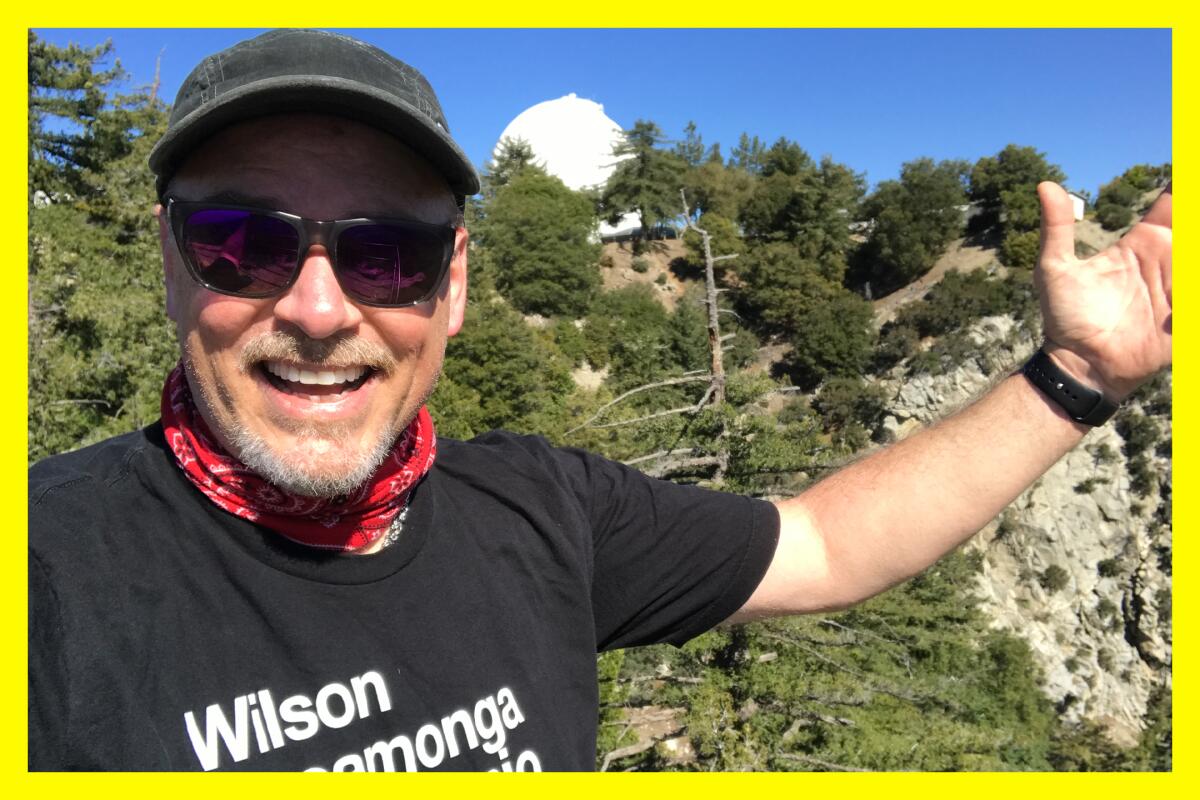
Jeff Hester after hiking Mt. Wilson, one of the original peaks on the Six Pack of Peaks SoCal challenge.
(Courtesy of Jeff Hester)
While on the mend, he took on the 211-mile John Muir Trail, which starts in Yosemite National Park. He’d hiked the trail in 1980 and wanted to do it again 30 years later.
Hester came up with the phrase “six pack of peaks” to describe the summits that he and his friends — including his then-girlfriend, Joan — would use to train: Mt. Wilson, Cucamonga Peak, Mt. Baldy, San Bernardino Peak, Mt. San Jacinto and San Gorgonio. Hester calculated that, altogether, these peaks would add up to 27,108 feet of elevation gain over 82 miles.
The training regimen worked — not only for the group, which successfully completed the John Muir Trail, but also for Jeff and Joan. They’ve been married 12 years.
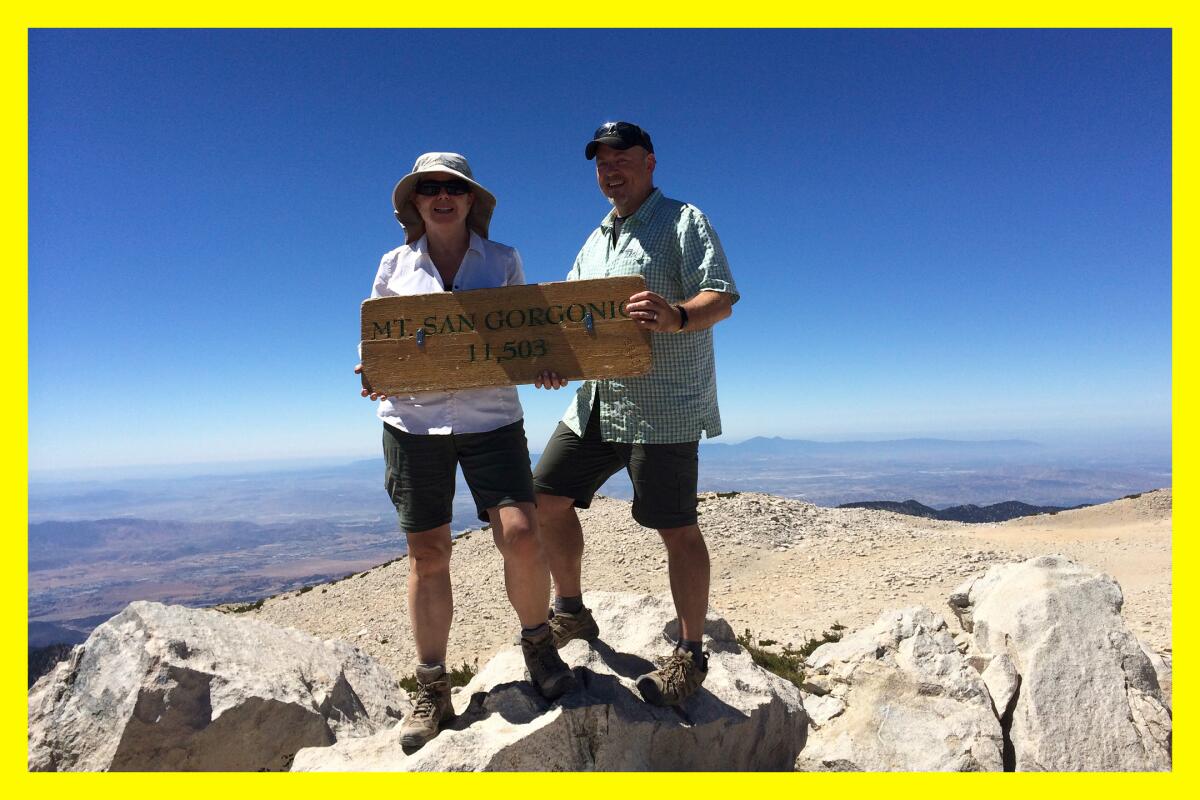
Jeff Hester and wife Joan at the San Gorgonio summit.
(Courtesy of Jeff Hester)
Hester posted his “six pack of peaks” training regimen on a blog. (It was, after all, 2010.) After that, he regularly heard from adventure bloggers and others who used the concept to train for Mt. Whitney and other big hikes.
In 2015, he launched the SoCal Six Pack of Peaks as a paid challenge. About 200 people signed up, and about half finished. They celebrated with a pizza party in Hollywood.
The community has continued to grow since then, with an untold number of folks who don’t pay the $50 to officially join the SoCal Six Pack of Peaks (or other Six Pack challenges), but who endeavor to climb the listed peaks. Hester’s program has since multiplied to 17 Six Pack challenges in 19 states.
Every person who signs up has the option to donate money outside their registration fee to Big City Mountaineers or an outdoors nonprofit that’s local to their challenge area. In the past eight years, the challenges have raised over $126,000 for these nonprofits.
I asked Hester whether he worries that the Six Pack challenges will flood certain trailheads with too many people. To prevent this from happening, his company partners with Leave No Trace, which identifies hiking hotspots from year to year, and publishes its reports online. He’s changed the lineup of the Colorado challenge’s peaks after the nonprofit identified some of them as being overutilized.
That said, Hester suggests that AllTrails and Instagram probably drive more crowding to trails than his arguably small community of hikers, each of whom receives educational materials when they sign up on how to follow Leave No Trace’s seven principles.
“There’s probably more people on Mt. Baldy on a given weekend than we have signed up for the whole year,” Hester said.
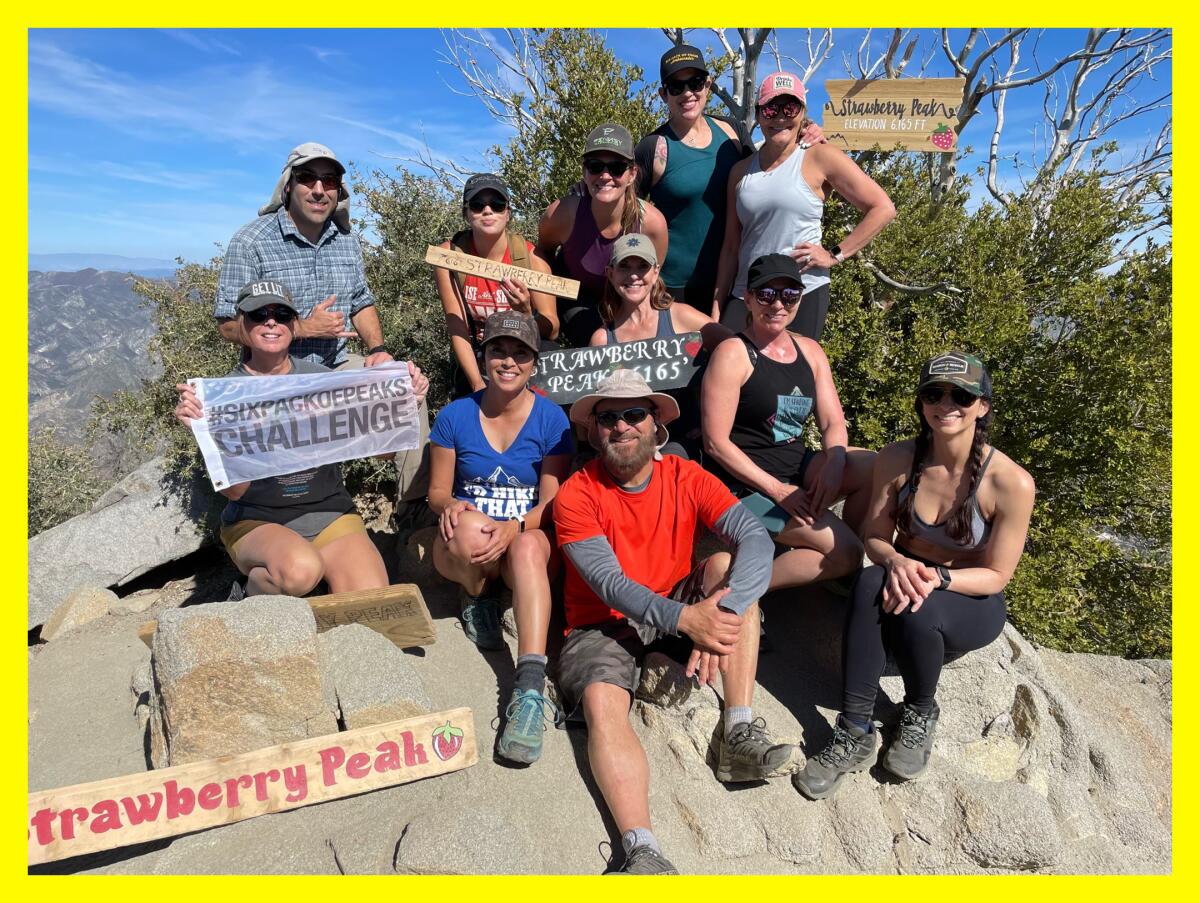
Carisa Hernandez at Strawberry Peak with other Six Pack of Peak participants.
(Courtesy of Carisa Hernandez)
The best part of joining the Six Pack of Peak challenge is the community, says 48-year-old hiker Carisa Hernandez of Rancho Cucamonga.
Hernandez started hiking in 2010, when her family was going through a difficult time, and her Aunt Francine took her out in nature to help her de-stress. One hike and Carisa was hooked.
For months, they hiked a five-mile mostly flat loop at the Claremont Hills Wilderness Park. Then her aunt suggested they try something “not that much more difficult” — Mt. Baldy. She loved that, too, but soon wanted more. Researching online, she stumbled across Hester’s challenge and signed up. She felt prepared to complete Mt. Baldy, but was intimidated by others on the list.
“But the fact that it’s a challenge — I tend to be a little more of a competitive person so it was exciting,” she said.
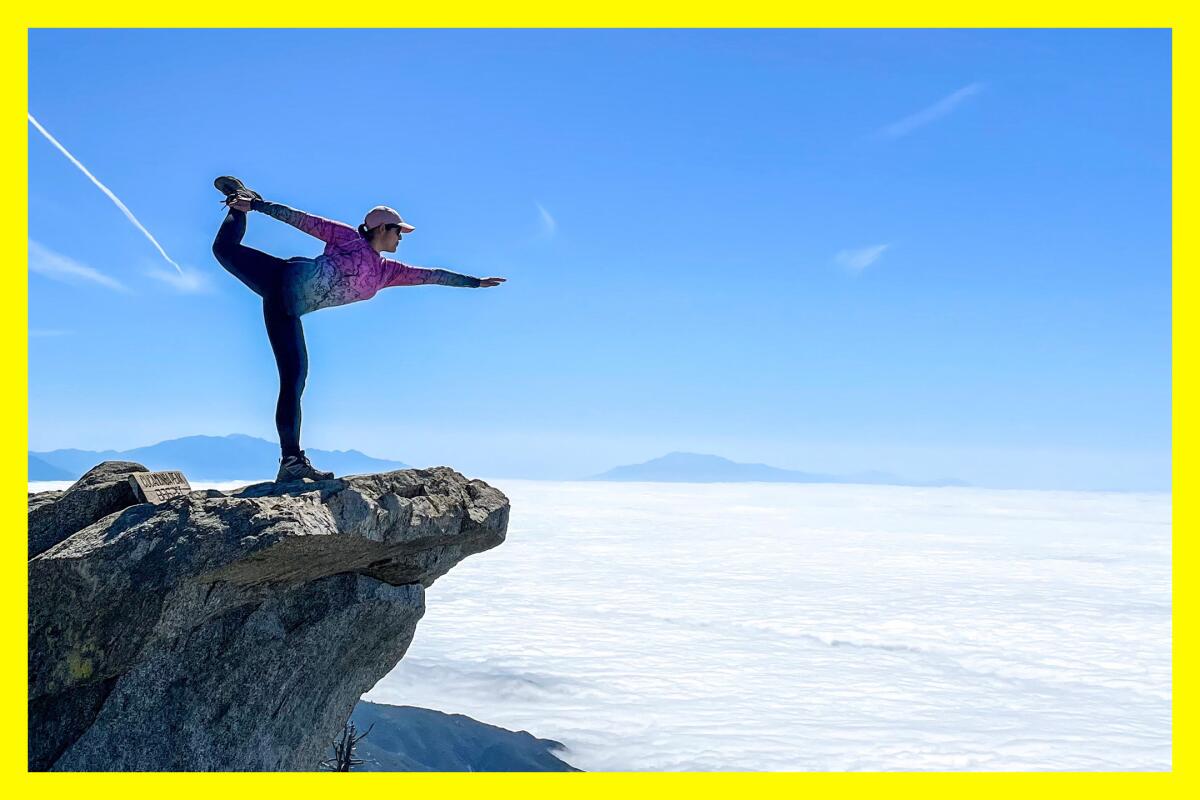
Carisa Hernandez at the summit of Cucamonga Peak, one of the peaks on the Six Pack challenge.
(Courtesy of Carisa Hernandez)
Hernandez is in her eighth year of completing the SoCal Six Pack of Peaks challenge. She’s hiked Mt. Kilimanjaro in Tanzania and Mt. Whitney with friends she’s met through the program. She and her friends plan to complete her ninth summit of Mt. Whitney this year.
Whenever Hernandez is traveling to another state, she checks to see whether it has a Six Pack of Peak challenge. If so, she hops on the group’s forum, where she knows people will give her tips on the best trails.
“In the beginning, it was more about the challenge, and to see how far I could go, and what I could accomplish,” Hernandez said.
Now, she said, it’s more about the friendships.
See you out there,
Jaclyn

3 things to do
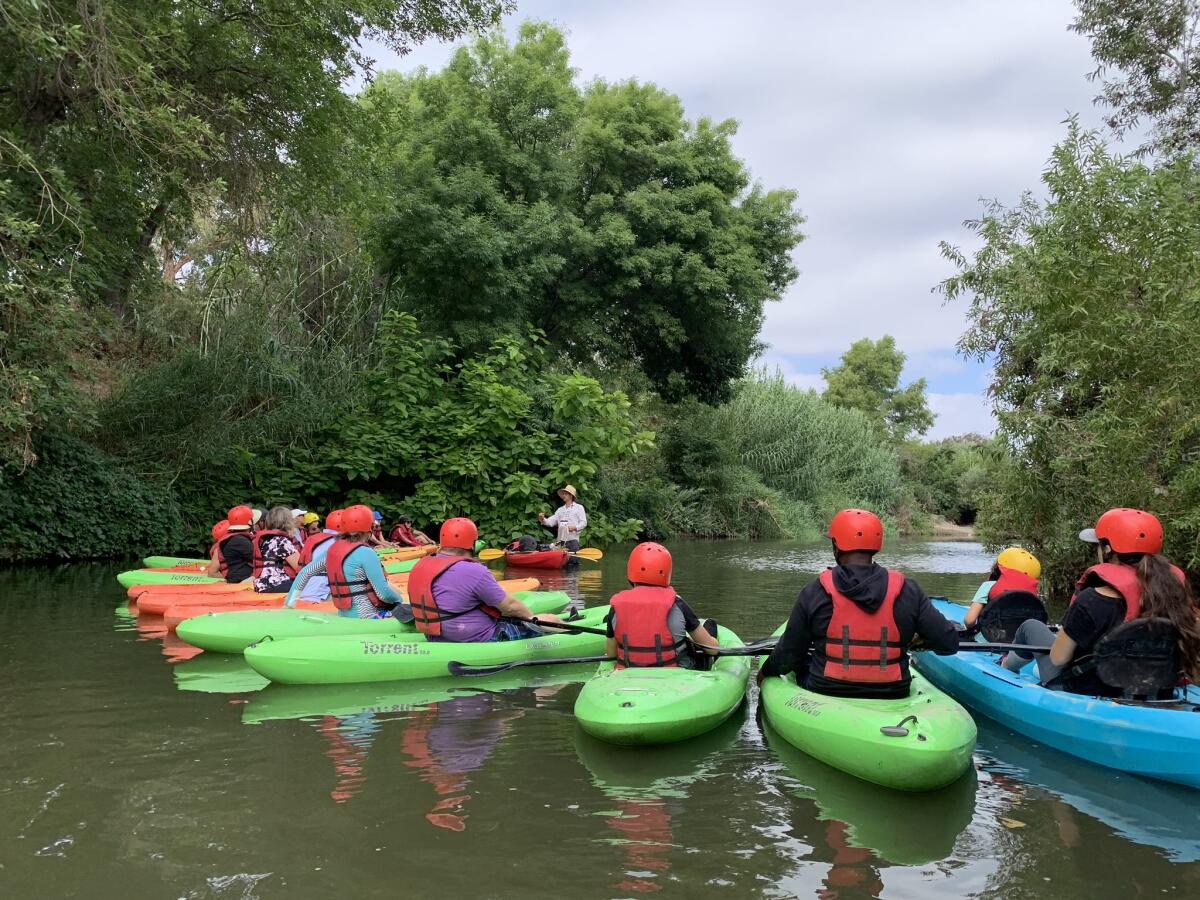
(Courtesy of Dayana Doroteo)
1. Kayak through the Sepulveda Basin Wildlife Reserve in L.A.
Enjoy a leisurely 2.5-mile flat-water paddle through the Sepulveda Basin Wildlife Reserve, a 225-acre refuge, and a larger basin area with thousands of native plants and many animals. You’ll traverse through tree-lined riverbanks with deeper water and fewer obstacles than the rest of the L.A. River. It’s a great spot for birding, where you might spot rare or hard-to-find birds, including breeding blue grosbeaks. The trip, hosted by L.A. River Expeditions, takes about 2 1/4 hours and costs $53.74. Register for a Saturday or Sunday trip in July or August through Eventbrite. Call (747) 465-0496 for more information, including how to snag family and large-group discounts, or book a private tour for a special event.
2. Celebrate National Moth Week at your local L.A. County park
Perhaps you fancy the California pyrausta. Or maybe you like the large cecropia moth. During National Moth Week, which runs from Saturday to July 28, you can visit any one of nine L.A. County parks from 7 to 9 p.m. to learn about these nocturnal beauties. Naturalists will be on hand, attracting moths to light. There will also be short hikes, crafts and other free activities for all ages. For more information, call 626-223-7718.
3. Bike along the upper Arroyo Seco near Pasadena
Join San Gabriel Valley nonprofit ActiveSGV for a free 12-mile bike ride, mostly on city streets, from 7 to 9:30 p.m. Saturday along the upper Arroyo Seco. Along the way, you’ll learn about efforts to protect the San Gabriel Mountains and how you can get involved. The ride starts and ends at Pasadena Central Park, 275 S. Raymond Ave. Bring your bike or another wheeled device and a front and rear light. A helmet is required for riders younger than 18, and geared bikes are recommended. Bikes with training wheels are not permitted, but children are welcome to attend if carried in a trailer or on-bike child seat. Register for this free event on Eventbrite.

The must-read
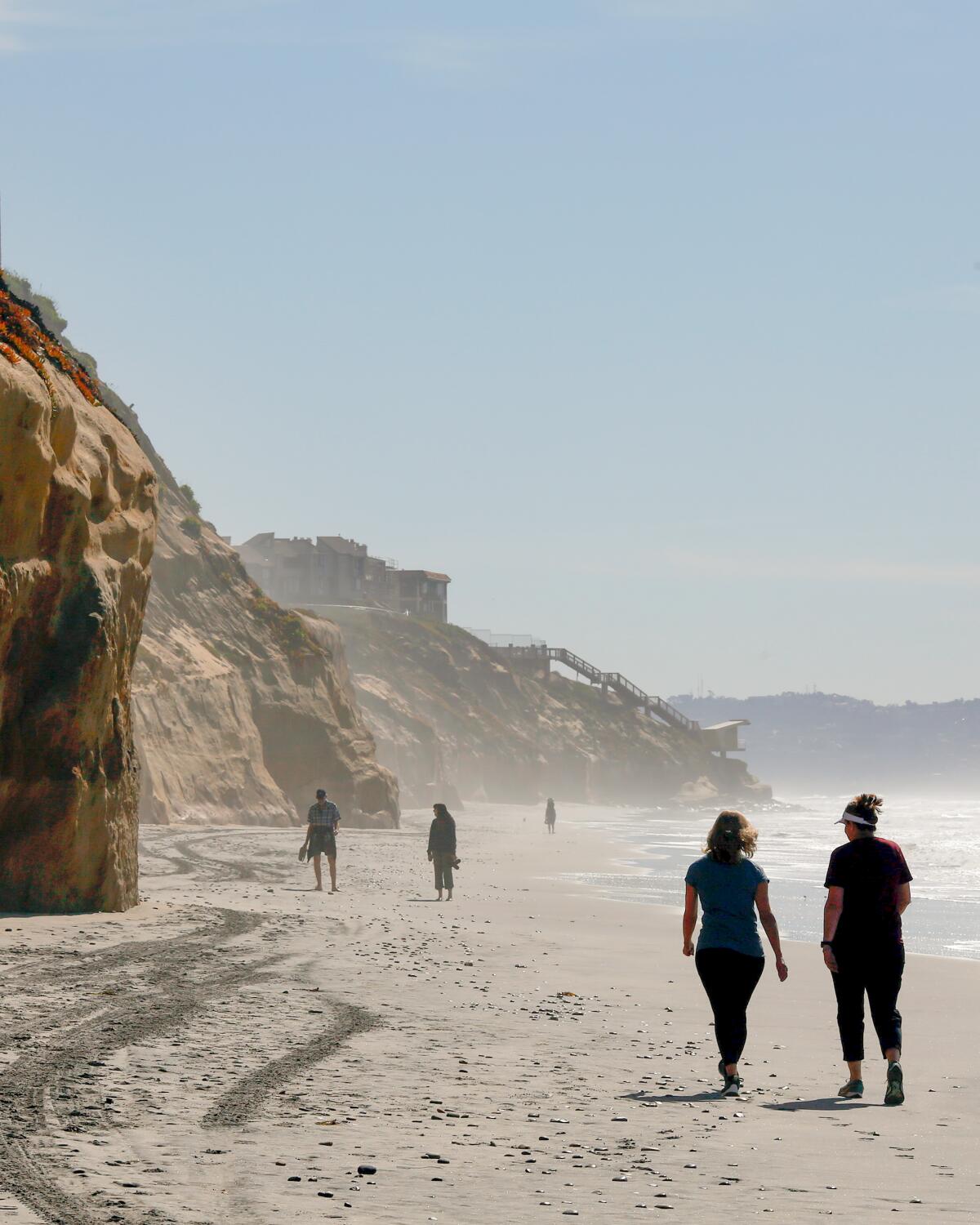
Visitors at Fletcher Cove in Solana Beach.
(Dania Maxwell/Los Angeles Times)
Whenever our friends or family visit us and want to go to the beach, I always suggest we skip the tourist spots and hit a locals beach. My usual spot is Leo Carrillo State Beach, where I’ve lounged with my parents, flown kites and, most recently, investigated the tide pools.
As my colleague Kailyn Brown wrote in our 50 best beaches of Southern California guide, Leo Carrillo “is where you go to explore.”
For our beach guide, my colleagues visited more than 200 miles of coastline, picking through hundreds of beaches. They prioritized beaches that were easy enough to reach (although some have a remote feel) and special amenities — like firepits, volleyball courts, camping, surf conditions and views. Most have accessibility options, and all but three have bathrooms — although cleanliness will vary. Several beaches on our list are even dog friendly, including Arroyo Burro Beach in Santa Barbara. My dog and I might just check that out this weekend!
Happy adventuring,

P.S.
Officials at Angeles National Forest would like the public’s thoughts on their plan to increase fees at 10 developed campgrounds. Fees would increase at popular campgrounds, including Monte Cristo, Chilao and Buckhorn Campgrounds, from $5 or $12, to $20 per single site per night. You can see the full list here. You have until Sept. 3 to submit comments online, by email to [email protected], or by mail to Angeles National Forest, ATTN: Jeremey Sugden, 701 N. Santa Anita Ave., Arcadia, CA 91006.
One more thing: Have you gone on summer vacation yet? If so, how much did you spend on it? The Times is gathering stories from readers about the cost of summer vacation. Share your story here.
For more insider tips on Southern California’s beaches, trails and parks, check out past editions of The Wild. And to view this newsletter in your browser, click here.
